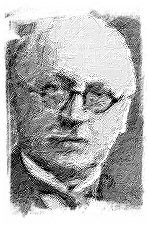Edwin Lutyens Biography

Edwin Lutyens has designed some of the most splendid monumental buildings in the Indian capital of New Delhi and a number of World War I memorials which had a major influence on design of memorial monuments worldwide. Although Lutyens is renowned for his architectural masterpieces, he also designed outstanding pieces of furniture of which is best known the so-called Lutyens bench marked by timeless elegance and extraordinary functionality which make it a popular garden addition for more than 100 years.
Edwin Lutyens was born in London in 1869 to Charles Henry Augustus Lutyens and Mary Theresa Gallwey who named their son after their friend Edwin Henry Landseer, the respected English painter and sculptor. He spent his childhood in the village of Thursley in Surrey and studied architecture at the South Kensington School of Art, London. He graduated in 1887 and joined the architectural practice Ernest George and Harold Peto in the same year. However, he left Ernest George and Harold Peto already in 1888 and opened his own practice. He mostly designed country houses in the Arts and Crafts style but Gertrude Jekyll, a highly influential horticulturist and garden designer also encouraged him to design garden furniture. It was his partnership with Gertrude Jekyll which led to creation of the impressive Lutyens bench as well as the unique Lutyens-Jekyll garden style which has profoundly influenced the English garden design.

By the end of the 19th century, Lutyens established himself as an influential architect but at the same time, his designs moved towards classicism which, however, revealed an outstanding feeling for functionality and modern sophistication. Before the outbreak of World War I, he was commissioned to design the new imperial capital of India – New Delhi. In association with Herbert Baker whom he met while working at the Ernest George and Harold Peto architectural practice, he designed the impressive India Gate and the Rashtrapati Bhavan (today’s official residence of the President of India). He is also credited with the so-called Lutyens Bungalow Zone, houses for the British officials and their offices on an area covering more than 2,800 hectares but he actually designed only four bungalows at the Rashtrapathi Bhavan. He worked on designing the layout and buildings in New Delhi nearly for two decades (from 1913 to 1930) but he meanwhile also worked on other projects of which are best known his World War I memorials and the Queen Mary’s Dolls’ House. In 1929, he also started to work on the design for a new Roman Catholic cathedral in Liverpool the construction of which, however, was interrupted by the outbreak of World War II. He died in 1944 before completing the cathedral, while Frederick Gibberd who built the present-day cathedral in 1967 did not follow his plan.
Edwin Lutyens was married to Lady Emily Bulwer-Lytton who bore him five children. His marriage, however, was less successful than his career. Nevertheless, his daughter Elisabeth Lutyens became a successful composer, while the youngest daughter Mary Lutyens became a writer. She is best known for her biographies of the Indian philosopher Jiddu Krishnamurti who was in close relationship with Lady Emily.